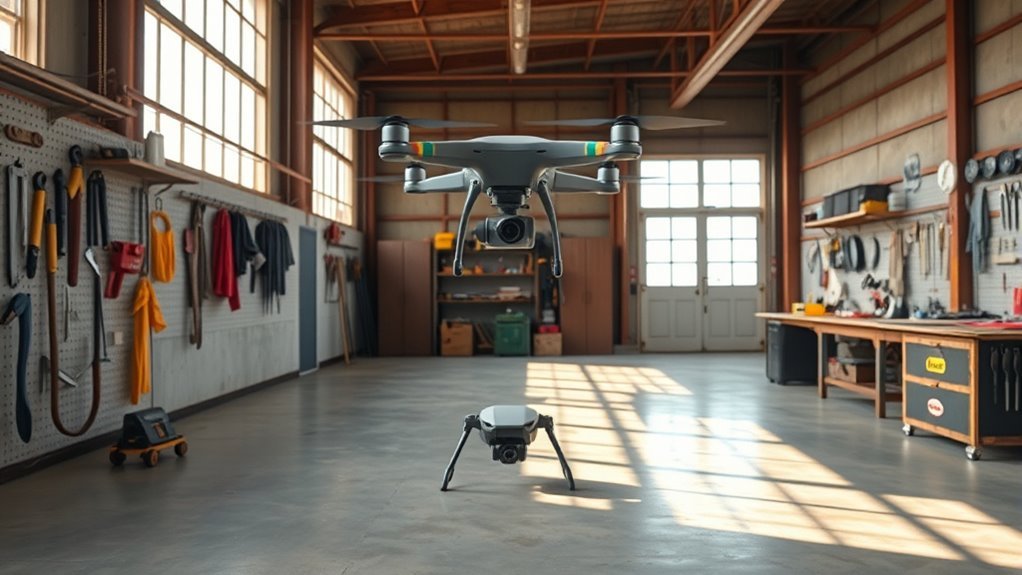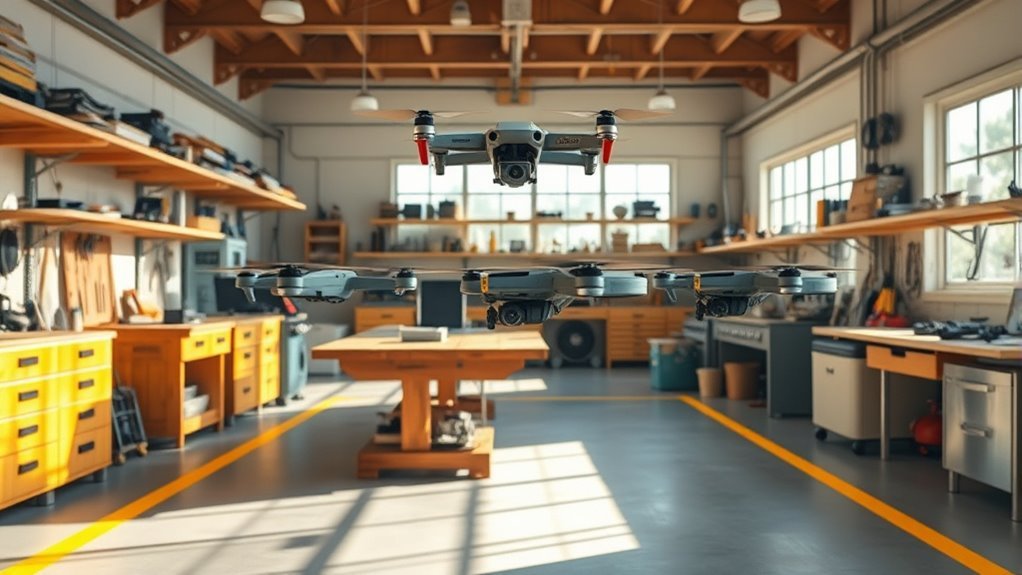To make your rust shop accessible for drones, assess your current layout to identify obstacles and optimize flight paths. Design drone-friendly workspaces with clear corridors and adjustable workstations. Implement safety measures by conducting risk assessments and training staff on operational protocols. Establish dedicated flight paths while integrating technology for better drone management. Regular maintenance is essential for performance and safety. Discovering further strategies can greatly enhance your drone operations in the shop.
Assessing Your Current Shop Layout

To kick off the process of making your rust shop drone-friendly, you’ll need to assess your current shop layout. Begin by evaluating the available space, noting any obstacles that hinder drone movement. Identify high-traffic areas where optimizing flow is essential, ensuring drones can navigate efficiently without disruption. Consider vertical space usage; tall shelves might require reconfiguration to prevent collisions. Next, document the equipment placement and workflows, pinpointing bottlenecks that could impede aerial operations. This analysis will help you create a clear blueprint for modifications. By focusing on these elements, you’ll lay the groundwork for an environment that embraces drone technology, enhancing productivity while maintaining a sense of freedom in your work processes. Additionally, understanding signal range will help ensure stable communication with drones during operation. Furthermore, consider the impact of environmental factors like wind and terrain to ensure safe and efficient drone flights within your shop.
Designing Drone-Friendly Workspaces

To create a drone-friendly workspace, you need to establish clear flight pathways that minimize obstacles and guarantee safe navigation. Additionally, adjustable workstation heights can accommodate various drone sizes and tasks, enhancing operational efficiency. By prioritizing these design elements, you can optimize your shop for drone integration. Furthermore, incorporating advanced flight modes can aid in maneuvering drones effectively within the workspace, ensuring safety and precision. The DJI Air 3S’s longer flight endurance allows for extended operations, making it a suitable choice for more complex drone tasks.
Clear Flight Pathways
While designing a drone-friendly workspace, establishing clear flight pathways is essential for both safety and efficiency. You need to prioritize unobstructed routes that facilitate smooth drone navigation. Start by mapping out designated areas where drones can operate without interference. Utilize signage or color-coded lines to guide their movement, making it easier to avoid collisions. Incorporate advanced obstacle detection systems to enhance safety; these systems can help drones identify and avoid unexpected barriers. Regularly assess these pathways, ensuring they remain clear of clutter and hazards. By creating a streamlined environment, you empower drones to navigate effectively, minimizing risks while maximizing operational capabilities. This proactive approach not only enhances productivity but also fosters a culture of innovation within your workspace.
Adjustable Workstation Heights
Adjustable workstation heights are essential in creating a drone-friendly environment, as they accommodate various tasks and user preferences. By incorporating ergonomic adjustments, you can guarantee that each user can operate efficiently, reducing fatigue and enhancing productivity. Height versatility allows you to customize your workspace for different activities, whether it’s assembling drones or performing maintenance checks. This flexibility not only promotes comfort but also guarantees that all team members can engage with the workspace effectively, regardless of their physical stature. Furthermore, integrating height-adjustable tables or platforms fosters collaboration, enabling seamless interaction during group projects. Ultimately, prioritizing adjustable workstation heights will empower your team, making your shop more accessible and conducive to drone-related tasks.
Implementing Safety Measures

As you integrate drones into your rust shop operations, implementing safety measures becomes essential to guarantee a secure working environment. Start by conducting thorough risk assessments to identify potential hazards associated with drone usage. Familiarize yourself with safety regulations to confirm compliance and minimize risks. The Dji Mini 2, with its 12MP sensor, offers excellent image resolution and can be an asset in monitoring shop conditions. Drones like the DJI Mavic 3 Pro provide longer flight times, allowing for more extensive inspections and efficient monitoring of shop conditions.
| Safety Measure | Importance |
|---|---|
| Regular Maintenance | Prevents mechanical failures |
| Employee Training | Enhances awareness and response |
| Safety Signage | Guides safe drone operation |
| Emergency Protocols | Guarantees swift incident response |
Establishing Drone Flight Paths
After implementing safety measures, the next step is to establish clear drone flight paths within your rust shop. Start by evaluating the layout and identifying areas where drones can operate without interference. Utilize flight zoning to designate specific routes, ensuring compliance with drone regulations. Mark these paths clearly to guide drone operators and minimize risks. Consider potential obstacles, such as machinery and personnel, and adjust flight paths accordingly. Integrating technology like mapping software can enhance the precision of your designated routes. Additionally, leveraging advanced sensors and AI can help optimize real-time monitoring of drone activities. Remember, clear communication of these flight paths is essential for maintaining safety and efficiency. By taking these steps, you create a structured environment that allows for freedom of movement while adhering to necessary regulations. Additionally, understanding flight stability is crucial for ensuring safe operations in dynamic environments.
Training Staff for Drone Operations
To guarantee safe and efficient drone operations within your rust shop, it’s essential to train your staff effectively. Implementing thorough drone operation protocols is vital. Start by developing clear guidelines that outline operational procedures, safety measures, and emergency protocols. Next, consider enrolling your team in staff certification programs tailored to drone operations. These programs not only enhance skills but also secure compliance with industry regulations, fostering a culture of safety and responsibility. Regular training sessions will keep your staff updated on evolving technologies and best practices, empowering them to operate drones confidently. By investing in your team’s training, you create an environment where drones can be utilized freely while maintaining operational integrity and safety within your shop. Additionally, prioritizing AI detection systems in your training curriculum can help staff understand the importance of real-time obstacle navigation for enhanced safety. Incorporating advanced analytics into your training can also provide staff with insights that enhance their decision-making capabilities during operations.
Integrating Technology for Drone Management
With your staff trained in drone operations, the next step involves integrating technology for effective drone management. Implementing advanced drone software is essential for optimizing aerial navigation and guaranteeing seamless flight paths. This software can facilitate real-time data analysis, enabling your team to monitor drone performance and environmental conditions. Additionally, consider deploying a centralized management system that allows you to coordinate multiple drones simultaneously, enhancing operational efficiency. Advanced collision avoidance features ensure safety and compliance with FAA regulations while verifying compatibility with existing hardware and providing robust cybersecurity measures to protect sensitive data. By leveraging these technologies, you’ll empower your staff to exercise greater control and flexibility in drone operations, ultimately maximizing productivity while maintaining safety standards. Embrace this integration to elevate your shop’s capabilities and foster a culture of innovation. Moreover, the software’s real-time data processing capabilities ensure that your team can adapt quickly to changing conditions and make informed decisions on the fly.
Regular Maintenance and Upgrades for Drone Accessibility
While ensuring your drones are accessible for operations, regular maintenance and timely upgrades are critical. You need to implement a systematic drone maintenance schedule to keep your fleet in prime condition. This includes checking battery health, calibrating sensors, and updating software to enhance performance. Accessibility upgrades, such as improved landing zones and obstacle detection systems, should also be prioritized to facilitate seamless operations. Regularly evaluating your shop’s layout for compatibility with drone necessities will prevent operational hiccups. By focusing on these aspects, you not only enhance functionality but also safeguard your investment, allowing you to maximize efficiency and flexibility in your operations. Additionally, understanding the RTK capabilities of your drones can help you optimize their use for various surveying applications. Understanding local drone regulations is essential to ensure that your operations remain compliant and safe. Keep your drones ready for action, and you’ll experience the freedom that comes with reliable technology.
Frequently Asked Questions
What Types of Drones Are Best for Shop Operations?
When considering drone types for shop operations, focus on multi-rotor drones for agility and fixed-wing drones for coverage. Each enhances shop efficiency, enabling streamlined processes and greater operational freedom in managing inventory and deliveries.
How Do I Ensure Privacy When Using Drones?
To safeguard your privacy while flying drones, adhere to drone regulations and establish robust privacy policies. Like a fortress, these measures protect your freedom, ensuring your operations remain secure and respectful of others’ boundaries.
Can Drones Be Used Indoors Safely?
Yes, drones can be used indoors safely, provided you follow drone regulations and prioritize indoor safety. Guarantee adequate space, avoid obstacles, and maintain control to prevent accidents while enjoying the freedom of indoor drone operation.
What Are the Costs Associated With Drone Implementation?
When considering drone implementation, you’ll face an initial investment for purchasing equipment and software, alongside ongoing maintenance costs. These factors are essential for ensuring operational efficiency while maximizing the benefits of drone technology in your projects.
How Do Weather Conditions Affect Drone Operations?
Weather conditions greatly impact drone operations, imposing operational limitations like reduced visibility or high winds. You’ll need to assess these weather impacts carefully to guarantee safe and efficient drone performance in various atmospheric scenarios.

